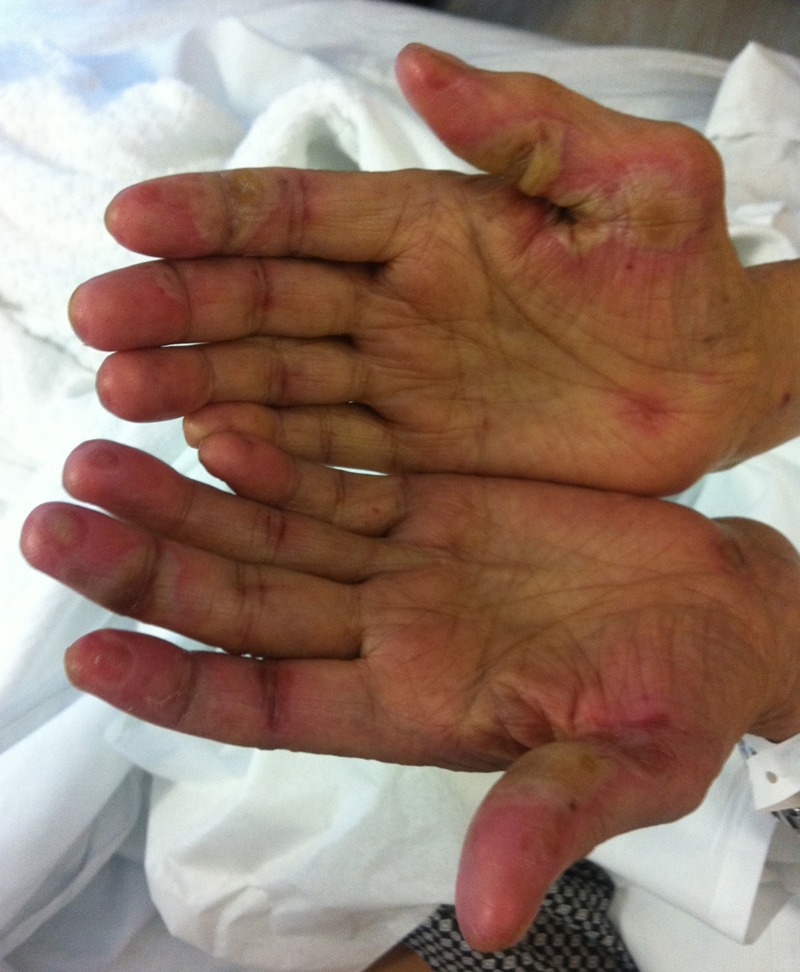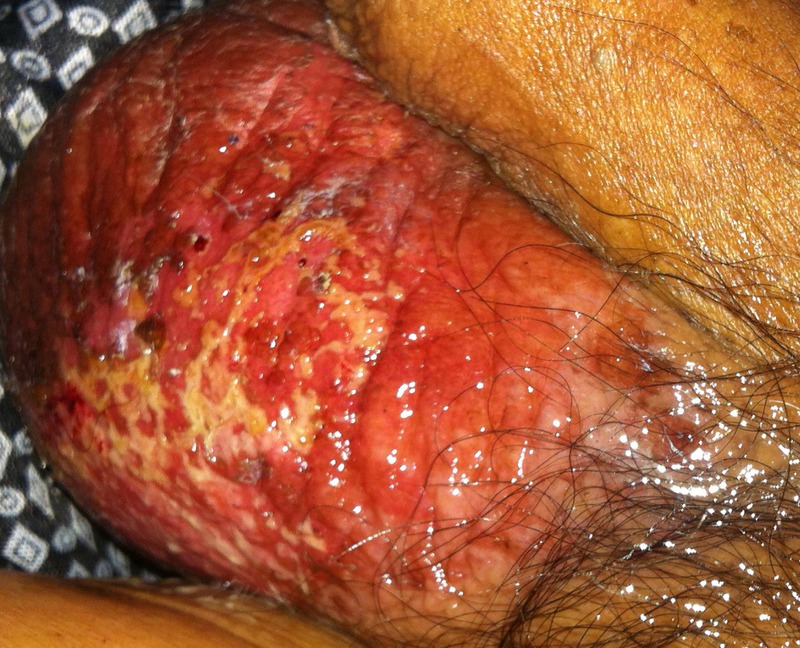Abstract
Tyrosine kinase inhibitors are novel antineoplastic drugs that make use of the molecular abnormalities that have been discovered in certain types of tumours. These agents are associated with important dermatological side effects. This case report discusses an atypical presentation of the hand–foot syndrome in one patient treated with sorafenib. A 78-year-old man, recently started on sorafenib for the treatment of hepatocarcinoma with lung metastasis, presented to the emergency room with painful blistering lesions on the palms, soles and scrotum for 1 week. A punch biopsy was performed and sorafenib was withheld. Direct immunofluorescence study was negative for an autoimmune blistering disorder and histopathology stains did not show any microorganisms. A diagnosis of hand–foot syndrome was made. After 2 weeks, the patient showed marked improvement and the plan was to restart sorafenib at a lower dosage.
Background
We present a case report that shows an atypical presentation of the hand–foot syndrome in a patient treated with a tyrosine kinase inhibitor. This case is notable, because tyrosine kinase inhibitors are relatively novel antineoplastic drugs that are becoming extensively used for different malignant conditions. Unfortunately, these agents are associated with important dermatological side effects, which are generally benign, but can create discomfort and anxiety among the patients. In an era of extended chemotherapy use, the clinician should be familiar with the dermatological side effects inherent to tyrosine kinase inhibitors; this will allow an early instauration of effective therapeutic measures and reassurance.
Case presentation
On September 2013, we admitted a 78-year-old man, who presented to the emergency room with 1 week of painful blistering lesions on the palms, soles and scrotum. He denied fever, chills and pruritus of the lesions. The patient had a medical history of type II diabetes, hypertension, chronic hepatitis C, hepatocellular carcinoma with lobectomy in 2007 and radiofrequency ablation in 2011. The patient was recently diagnosed with lung metastasis and was started on sorafenib 3 weeks prior to admission.
On physical examination, vital signs were within normal limits, skin examination was notable for several well-defined tense bullae over the palmar and plantar aspects of the hands and feet, as well as an area of erythematous denuded skin over the scrotum (figures 1 and 2). The lesions were exquisitely tender to palpation and limited the patient from walking or grasping objects.
Figure 1.

Symmetrical erythema and blistering of palms and fat pads of distal phalanges.
Figure 2.

Well-defined erythematous denuded patch over the scrotum.
Investigations
Initial laboratory workup revealed normal white cell count, a creatinine level of 1.6 mg/dL (baseline) and electrolytes within normal limits.
Differential diagnosis
An initial diagnosis of Stevens-Johnson syndrome was suspected, but the patient did not have the typical prodrome of fever with influenza-like symptoms and he lacked mucous membrane involvement. Erythema multiforme (EM) was also considered, but he did not present target lesions. Moreover, the cutaneous lesions in EM most commonly appear in a symmetrical distribution on the extensor surfaces of the acral extremities, and subsequently spread in a centripetal manner. The patient did not look toxic, his vital signs were stable and no fever or hypothermia was reported, making an infectious process less likely. With the history of recent initiation of sorafenib, the diagnosis of hand–foot skin reaction seemed to be attractive. Pemphigus, bullous pemphigoid and paraneoplastic pemphigus were also considered within the differential diagnosis.
Treatment
The patient was admitted to the medicine ward for observation and a punch biopsy was performed. Under the suspicion of hand–foot skin reaction, he was started on topical steroids over the lesions localised on the hands and feet, and topical emollients over the scrotum. He also received analgesics. Sorafenib was withheld.
Outcome and follow-up
The patient remained stable overnight with no emergence of new cutaneous or mucous lesions. He was discharged home the next day after performing biopsies.
Histopathology reported epidermis with extensive neutrophil infiltration, focal necrosis and scattered bullous lesions. Immunofluorescence study was negative for an autoimmune blistering disorder, and the different stains were negative for any kind of microorganism.
Two weeks after discharge, the lesions had improved remarkably and were no longer painful. At that time, the plan was to restart sorafenib at a lower dose.
Discussion
The hand–foot skin reaction was first reported in association with chemotherapy in 1974.1 Since then, it has been known by many terms including: palmar–plantar erythrodysesthesia, acral erythema, toxic erythema of the palms and soles, hand–foot syndrome and Burgdorf's reaction. Many drugs have been implicated as causative agents of this reaction: cytarabine, capecitabine, 5-fluorouracil and many more.2–5 Recently, a relationship between tyrosine kinase inhibitors and the hand–foot syndrome has been reported.6 The prevalence of hand–foot skin reaction is 10–28% among patients treated with sunitinib, and 10–62% in patients treated with sorafenib.7
The clinical appearance of the hand–foot skin reaction is often characterised by symmetrical erythema and oedema of the palms and soles, which usually progresses to blistering and necrosis. Most patients with acral erythema induced by kinase inhibitors seem to have more localised and hyperkeratotic lesions that are distinct from classic hand–foot syndrome. Patients treated with kinase inhibitors can develop other numerous cutaneous side effects: folliculitis, hair modifications, paronychial inflammation, xerosis, subungual splinter haemorrhages and periocular oedema.8
Only a few cases of scrotal lesions associated with the hand–foot syndrome have been reported.9
The pathogenesis of acral erythema is still unknown, but the dose dependence in most cases suggests a direct toxic effect of the causative agent.8
The diagnosis of this reaction remains primarily clinical and the physician has to have a high degree of suspicion in a patient receiving chemotherapy who develops suggestive lesions on the palms and soles. Histological examination is not necessary for diagnosis, but when performed has showed epidermal parakeratosis and dyskeratosis with band-like areas of necrotic keratinocytes. Superficial bullous lesions are also present.8
The treatment is based on the severity of the lesions, remaining mainly symptomatic for mild disease, contact with hot water should be avoided as this is believed to exacerbate the symptoms and topical emollients can be used. For more severe disease, topical steroids and temporal discontinuation or dosage reduction of the offensive agent can be attempted. Keratolytics can be used if necessary.10 The prognosis of this disease is excellent.
The hand–foot syndrome can have atypical presentations, including scrotal lesions, like the patient depicted in this case report. This disease has an excellent prognosis, and usually resolves with topical steroids and emollients. Temporary withdrawal of the offending agent may be necessary.
Learning points.
Tyrosine kinase inhibitors are also associated with hand–foot skin reaction, a known side effect of conventional chemotherapy agents.
The hand–foot skin reaction is characterised initially by a tingling sensation in the palms and/or soles, followed by oedema and tender, symmetrical erythema. The affected areas may develop pallor, blistering and desquamation.
Some cases of hand–foot skin reaction involving the scrotum have been reported.
The diagnosis of the hand–foot skin reaction remains primarily clinical.
The treatment is mainly symptomatic for mild disease. For severe disease, topical steroids and temporary discontinuation or dosage reduction of the offending agent can be considered.
Footnotes
Contributors: JRG admitted the patient into the medicine ward and wrote the report. AMS looked after the patient and wrote the report. AB took care of the patient since admission to discharge and wrote the report. DL was the attending physician assigned to this patient. He reviewed the report before submission.
Competing interests: None.
Patient consent: Obtained.
Provenance and peer review: Not commissioned; externally peer reviewed.
References
- 1.Zuehlke RL. Erythematous eruption of the palms and soles associated with mitotane therapy. Dermatologica 1974;148:90–2 [DOI] [PubMed] [Google Scholar]
- 2.Farr KP, Safwat A. Palmar-plantar erythrodysesthesia associated with chemotherapy and its treatment. Case Rep Oncol 2011;4:229–35 [DOI] [PMC free article] [PubMed] [Google Scholar]
- 3.Ozmen S, Dogru M, Bozkurt C, et al. Probable cytarabine-induced acral erythema: report of 2 pediatric cases. J Pediatr Hematol Oncol 2013;35:e11. [DOI] [PubMed] [Google Scholar]
- 4.Eich D, Scharffetter-Kochanek K, Eich HT, et al. Acral erythrodysesthesia syndrome caused by intravenous infusion of docetaxel in breast cancer. Am J Clin Oncol 2002;25:599. [DOI] [PubMed] [Google Scholar]
- 5.Hoff PM, Valero V, Ibrahim N, et al. Hand-foot syndrome following prolonged infusion of high doses of vinorelbine. Cancer 1998;82:965. [DOI] [PubMed] [Google Scholar]
- 6.Lacouture ME, Reilly LM, Gerami P, et al. Hand foot skin reaction in cancer patients treated with the multikinase inhibitors sorafenib and sunitinib. Ann Oncol 2008;19:1955. [DOI] [PubMed] [Google Scholar]
- 7.Lipworth AD, Robert C, Zhu AX. Hand-foot syndrome (hand-foot skin reaction, palmar-plantar erythrodysesthesia): focus on sorafenib and sunitinib. Oncology 2009;77:257–71 [DOI] [PubMed] [Google Scholar]
- 8.Robert C, Soria JC, Spatz A, et al. Cutaneous side-effects of kinase inhibitors and blocking antibodies. Lancet Oncol 2005;6:491. [DOI] [PubMed] [Google Scholar]
- 9.Sapp CM, DeSimone P. Palmar-plantar erythrodysesthesia associated with scrotal and penile involvement with capecitabine. Clin Colorectal Cancer 2007;6:382. [DOI] [PubMed] [Google Scholar]
- 10.Lacouture ME, Wu S, Robert C, et al. Evolving strategies for the management of hand-foot skin reaction associated with the multitargeted kinase inhibitors sorafenib and sunitinib. Oncologist 2008;13:1001. [DOI] [PubMed] [Google Scholar]


